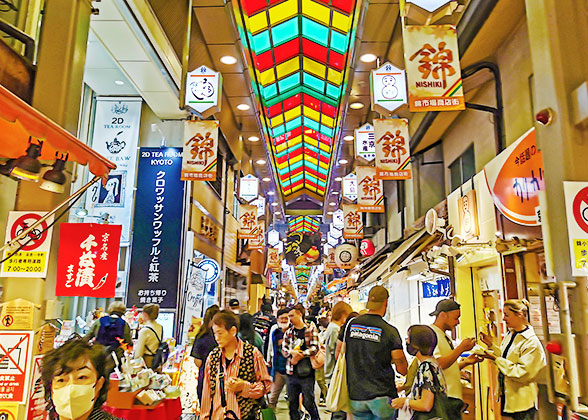Nishiki Market

Nishiki Market Photos ( 19
|
History of Nishiki Market
The story of Nishiki Market started in 1310, when a fish vendor chose this area to set up the first fish shop. As more fish shops flooded in, it became a prosperous wholesale market satisfying Japanese staggering demand of fish. During the Edo period (1603 -1868), the market was officially recognized by the Tokugawa Shogunate, and gradually developed to a shopping street, offering all manners of food commodities including pickles, which Kyoto is still proud of.
|
|
|
Top-Rated Food at Nishiki Market
Tsukemono, pickled vegetables and part of Japanese every meal
You would be astonished to know how Tsukemono, lightly pickled vegetables, dominate Japan’s food culture. It’s everywhere in Japan: in convenience stores, supermarkets, and every local-style restaurant, and Nishiki Market is where to find the best. There is even a Shinto God of Pickles and a festival for it! Of over 3,000 pickled types, cabbage, turnip, and cucumber are the most commonly seen to complement a meal. Just try these sour brined vegetables and let their lactic acid bacterium help you digest. “Sugukizuke”, pickled turnip, might interest you most as it’s one of the flagships of Kyoto.
Tou-nyuu doughnuts, must-try soy bean-made food
If you’ve ever paid attention to the must-try food of Nishiki Market, you might’ve noticed a snack called “tou-nyuu doughnuts”, or fried tofu donuts. Yuba, dried tofu skin and made by separating the film from boiled soy milk, is another mainstay of Japan to try. By the way, tofu is associated by Japanese with Zen Buddhism for its simple look and taste.
Recommended shop: “こんなもんじゃ”, pronounced as “kon-na-mon-jia”.
Takotamago, baby octopus with head stuffed with quail egg
Takotamago is one of the most sought-after food at Nishimi Market. The chewy texture of octopi, the soft quail egg, and the appetizing red color will make your day.Recommended shop: “櫂”, pronounced as “Kai”.
|
|
|
Tamagoyaki, golden lightly-sweet rolled omelettes in slices
Tamagoyaki is definitely a classic dish loved by Japanese kids and adults alike. It’s made by eggs whiskered, fried, and rolled to a fluffy chunk before being sliced to pieces. Ingredients like onion and fish meat are always added to enrich nutrition and flavor.Recommended shop: “三木鶏卵”, pronounced as “mi-ki-kei-ran”
Nigorizake, cloudy sake or alcoholic drink made from rice
Sip while eating! Your culinary tour at Nishiki Market would be perfected with sipping some sake, Japan’s national beverage. Nigorizake is the most popular at the 200-year-old shop we recommend.Recommended shop: “津之喜酒舗”, pronounced as “tsu-no-ki sake”
(All the shops recommended are time-honored and can be founded on Google Map. As food shops of Nishiki Market are also known for their free samples, you will find your favorite in no time!)
|
|
|
Nishiki Market Is More than Food
Truly, Nishiki Market is an iconic food street in Kyoto, but it’s actually more than that.Want some tools for kitchen? Browse in a 460-year-old cookware store named “有次” (Aritsugu). Also remember to appreciate paintings of Ito Jakuchu - a nationally treasured painter born at this place during the Edo period (1603 - 1868) - at the entrance and on the arcade ceiling. Seeking knowledge? Pray at Nishiki-Tenmagu Shrine at the eastern end of the street, which enshrines the God of Scholarship.
Know Before Going
![]() Go between 9:00 am and 6 pm. Some shops at Nishimi Market would close as early as 4:00 pm. It’s recommended you tackle your lunch here.
Go between 9:00 am and 6 pm. Some shops at Nishimi Market would close as early as 4:00 pm. It’s recommended you tackle your lunch here.
|
|
|
|
|
|
How to Get There?
From Kyoto Station, take the Karasuma Subway Line, get off at Shijo Station, and walk 5 minutes.
Nearby Don’t-Miss Attractions
Gion area is the origin place of Japan’s iconic Geisha culture, thick in an Edo-era vibe with traditional Japanese-style buildings packing the streets, including many teahouses dating back over 300 years. Visitors can particularly go to Hanami-koji Street for spotting some of these artistic ladies.
Yasaka Shrine sits at the eastern end of Shijo Avenue, the main road that runs through Gion. It’s fondly called Gion Shrine, for the epic Gion Festival held in the shrine every July for an entire month. This Yasaka Shrine is the head of over 3,000 Yasaka Shrines scattered in Japan.
Kennin-ji Temple was witness to the introduction of Zen Buddhism from China to Japan and the first Zen temple built in Kyoto. Lying at the southern end of Gion’s Hanami-koji Street, it’s a tranquil oasis for whoever seeking a moment of peace.
Nijo Castle was the temporary office and residence of the Tokugawa shoguns in Kyoto, the military leaders overpowering Japanese emperors during the Edo era. It provides insight into an interesting and monumental slice of Japan's past political history.
Nishiki Market Photos & more Kyoto Photos
